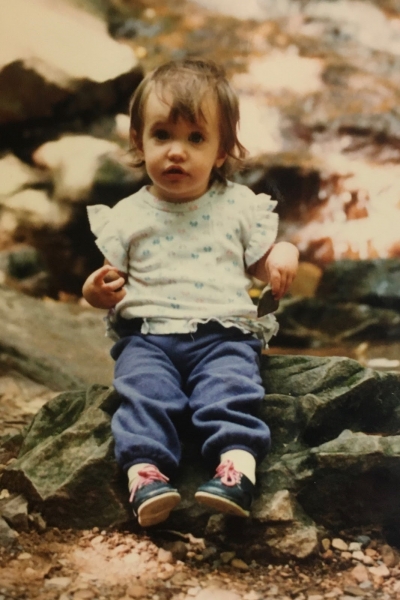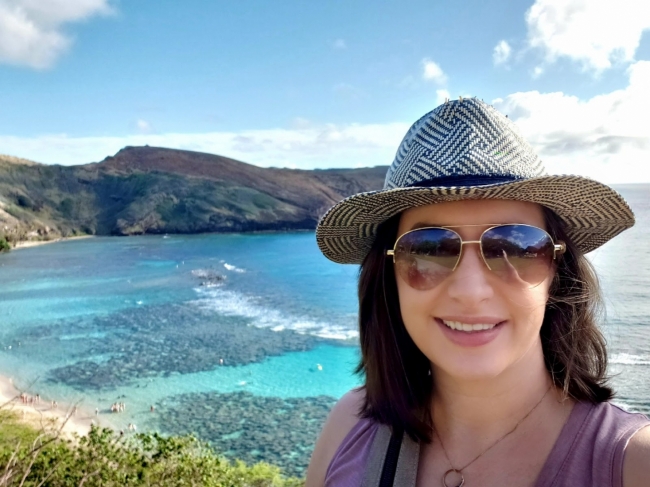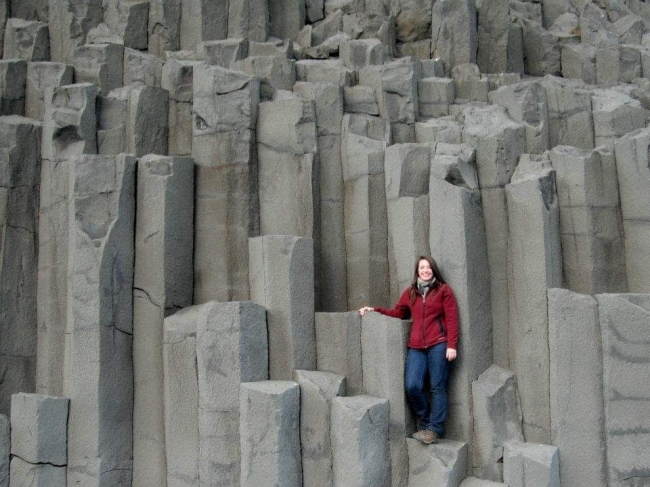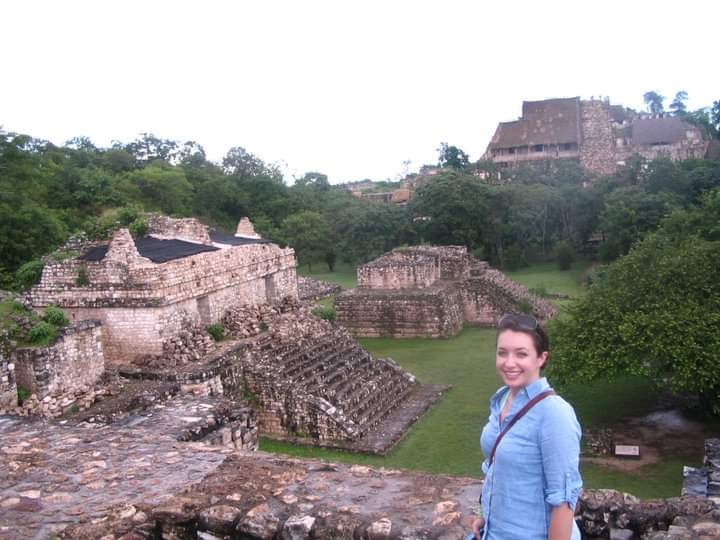This feature is part of a monthly series profiling scientists and technicians who provide exemplary contributions to the mission of NOAA’s Office of Response and Restoration (OR&R). In our latest "Minds Behind OR&R," we feature Natural Resource and Community Recovery Specialist Autumn Lotze.
Growing up, Autumn loved to explore the outdoors. Her parents, an accountant and a psychologist, took her and her siblings outdoors often, including many family camping trips.
“As a kid, I probably split a good deal of my time between climbing trees and keeping my nose in a book, and that hasn’t changed much as an adult (though with feet mostly on the ground these days),” Autumn said.
When she was younger, Autumn wanted to be Indiana Jones—to explore history and the natural world on adventures to exotic places. As she got older, she also came to appreciate the value of communities close to home.

Autumn’s hometown in northeastern Ohio has a strong slavic heritage and the community there really values its roots, she said. She became interested in issues of community identity, and when she left for college Autumn sought out programs in international studies, anthropology, and sociology. Through an interesting route, this eventually led her to emergency management.
While in college, Autumn had the opportunity to study abroad—once in Poland, and a second time in Hungary. Significant flooding was impacting Eastern Europe at the time. While volunteering for a human rights advocacy group, Autumn saw disproportionate impacts to marginalized populations that were very similar to those experienced after Hurricane Katrina, which had recently hit the Gulf Coast. Autumn became interested in the underlying causes of these disparities and decided to do her undergraduate thesis on socioeconomic structures and factors that impact disaster vulnerability.
After graduation Autumn moved to Washington, D.C. and spent four years working on commerce issues. Realizing she was still strongly interested in addressing disaster impacts, and wanting to take a holistic approach to disaster vulnerability and resilience, Autumn pursued a graduate degree in community and regional planning at the University of British Columbia.
Autumn focused her graduate thesis on modeling potential economic impacts of an earthquake on the regional business community. She then worked with a regional emergency management agency to design and implement a community preparedness project to address the research findings.
While attending the University of British Columbia, Autumn also spent some time at the University of Iceland working on a catastrophe management program—part of the United Nations’ Making Cities Resilient campaign. She enjoyed gaining more knowledge on risk reduction and management from an international perspective, and the collaboration with local agencies on resilience activities.
After graduating and returning to the U.S., Autumn took a position as a community mobilization associate at the American Red Cross headquarters in D.C. As part of the humanitarian organization’s community mobilization team, Autumn’s work focused on national level coalition building.
“These are whole-of-community challenges,” Autumn said. “In order to effectively prepare for and address them, we really have to build up whole community coalitions.”
When the grant Autumn had been working on through the Red Cross ended, she took a position with SBP, a New Orleans-based disaster recovery organization. Working in the Disaster Resilience and Recovery Lab, Autumn helped develop and implement national disaster preparedness and recovery navigation programs. She spent the next few years with SBP engaged in community level resilience building and helping disaster impacted areas navigate the recovery process.
In her SBP role, Autumn worked on projects ranging from communities in California post-wildfire to the Florida Keys after Hurricane Irma, both pre- and post-disaster. She delivered over 150 workshops and trainings around the country.
“It’s always been very edifying to me to be able to look at an issue or a challenge from a different set of eyes. We all have different experiences and look at things from different social and cultural perspectives,” Autumn said.
“I’ve had the privilege of working with some really incredible relief organizations, but over the course of that work something always in the back of my mind was climate change. It’s one of the defining challenges of our time, and the need to address it is imperative,” Autumn said. “Looking at NOAA as the federal agency leading climate science, it felt like an opportunity to contribute to being part of the solution to this global challenge we face. For me that was really exciting.”
Interested in NOAA programs with a disaster recovery focus, she came across the newest program at NOAA’s Office of Response and Restoration—the Disaster Preparedness Program.
“It seemed like a great fit,” she said. “With DPP, a growing program, and with disaster recovery as a new focus, I have the opportunity to play a role in building that out. Program building is something that I’m really energized about, identifying new opportunities to advance the agency’s mission and service to communities.”
In her role as a natural resource and community recovery specialist, Autumn leads the program’s recovery support portfolio. Her focus is the development and implementation of a programmatic framework for post-event recovery efforts across the National Ocean Service and NOAA.
“A lot of what I do is planning, capacity building, operational coordination, and partner engagement. One of the main ways I do that is by serving as NOAA’s action officer to the Recovery Support Function Leadership Group,” Autumn said. This interagency body brings together all the federal agencies with a role in disaster recovery and provides a forum for coordinating federal support to communities post-disaster and enhancing planning pre-disaster.
“There are a number of things that I really enjoy about the role. One is that I have the opportunity to work with so many different aspects of and entities within NOAA. Every day I’m working with different people across the National Ocean Service, in Fisheries, from the Research enterprise—it’s such a wide network of incredible people I get to collaborate with. I love the relationship building and continuous learning aspects of the work,” Autumn said.
“NOAA invests significantly in science and resources to help characterize future risks, such as sea level rise scenarios and inundation modeling that can inform rebuilding efforts. Tools that can aid in coastal vulnerability analysis, risk reduction, and resilience planning with future conditions in mind. These resources that NOAA provides can make a real difference for communities—if you’re planning for conditions today, that doesn’t mean you’ll be prepared for a situation you may find yourself in five or 10 years from now,” Autumn said. “If you can’t plan ahead for what you might expect in the future, you’re always going to be behind. You’re going to be reactionary. And we know in emergency management, that is the least efficient and most costly way to approach disasters. We want to not just to prepare for and mitigate today’s risks, but tomorrow’s as well.”
Autumn said that imagining a funnel is one way to think about the transition from disaster response to recovery. At the narrower end of the funnel is disaster response, where the roles and mission essential functions that NOAA carries out are very well defined, well established. The farther you get from the incident—when the focus moves from immediate life safety and incident stabilization to broader community recovery—the wider the variety of potential needs a community may have. When you’re three or six or twelve months out from a disaster, there can be many different kinds of issues requiring many different kinds of expertise and resources. A priority now is working to understand how NOAA can best engage and provide support in this much wider portfolio of potential needs.
“I think there’s a lot of growth and maturation happening across the federal recovery support space. And with the new Administration’s focus on addressing climate risk, considering what that means for programs going forward as well. The combination of policy leadership, technical expertise, and operational coordination is what ultimately gets us to service delivery for impacted communities. Providing operational coordination and support in the response space is part of the core of what DPP does for NOS, and it’s exciting for me to be a part of increasing that support in the recovery space,” Autumn said.
Autumn is based in the Washington D.C. area, where she enjoys cooking, reading, volunteering with her local community emergency response team and city archaeology program, and various outdoor pursuits outside the city, such as hiking and camping. She loves international travel, and looks forward to the day when she can safely travel again post-pandemic.


![Discussing dune protection and restoration at Playa Jobos, Puerto Rico [L-R: Robert Mayer - Professor & Director of Vida Marina: Center for Coastal Conservation and Restoration at University of Puerto Rico at Aguadilla; Donna Johnson, NOAA Fisheries; Autumn Lotze] Three people standing on a bridge.](https://rr-blog-s3fs.s3.us-west-2.amazonaws.com/s3fs-public/styles/large/public/blog-wysiwyg-images/IMG_0229.jpeg?VersionId=25uGE_dfTtSkSXrhmdrKAgGOedN7lmo1&itok=TH3U0Mrn)


